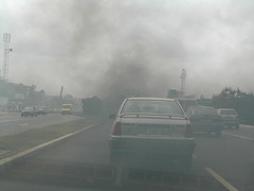Mobile phones aren't just for texting. An emerging field of research uses mobiles for "urban sensing," allowing phones to collect scientific data in new and innovative ways. The recently released UN/Vodaphone report, Wireless Technology for Social Change: Trends in NGO Mobile Use, describes this new field.
According to the report,
Mobile sensing—also known as ‘participatory sensing,’ ‘urban sensing,’ or ‘participatory urbanism,’—enables data collection from large numbers of people in ways that previously were not possible. By affixing a sensory device to a mobile phone, mobile sensing provides the opportunity to track multiple data points and collect dynamic information about environmental trends from ambient air quality to urban traffic patterns. “sparse sensing strategy does little to capture the very dynamic variability of air quality that depends on automobile traffic patterns, human activity, and output of industries.”
This technology has been used in Accra, Ghana to capture pollution data. The report describes the pilot study:
In the Accra study, seven taxi drivers were provided with a dash-mounted global positioning system (GPS) device and a tube to hang from their passenger window. The tube contained a carbon monoxide sensor. Similarly, three students were each given a mobile clip sensor pack containing a GPS device, and a carbon monoxide sensor. The taxi drivers and students were asked to carry their sensors as much as possible during their normal everyday activities. Throughout the day, the sensing system automatically logged sensor data. At the end of each day, the pilot participants dropped off their sensor packs at a central location where the data was then extracted and the sensors recharged. resulted from the participatory data collection A heat-map visualization of carbon monoxide readings across Accra, Ghana rendered atop Google Earth. Colors represent individual intensity reading of carbon monoxide during a single 24-hour period across the city. Red circles are locations where actual readings were taken.
The Accra study is one of the 11 case studies in the recent report Wireless Technology for Social Change: Trends in NGO Mobile Use, released this past Tuesday by the United Nations Foundation and The Vodafone Group Foundation. Katrin Verclas of MobileActive.org and Shelia Kinkade of ShareIdeas co-authored the report. The case studies in the report focus on the use of mobile phones in public health, humanitarian assistance and environmental conservation.
Photo credit to transaid.


Post new comment